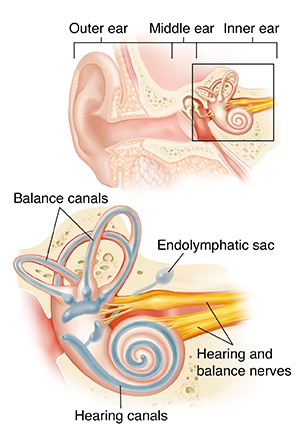There are 2 parts of the inner ear. One part (hearing canal or cochlea) is for hearing. The other part (balance canals, or semi-circular canals) is for balance.
The canals are filled with a fluid called endolymph. A small organ called the endolymphatic sac keeps the level of this fluid up. In the hearing canal, sound waves cause vibrations in the endolymph. The inner ear detects these sound waves. It then sends nerve signals to the brain. The sound we hear is a result of how the brain interprets these nerve signals.
In the balance canals, a change in position causes the fluid to move. This movement is detected in the balance part of the inner ear. Nerve signals are then sent to the brain.
The balance canals collect balance information. The hearing canal collects sound information. The hearing and balance nerves carry this information to the brain from both parts of the inner ear.


